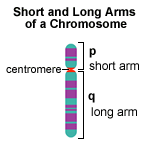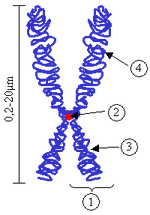
Short and long arms

Chromosome.
(1) Chromatid . One of the two identical parts of the chromosome after S phase.
. One of the two identical parts of the chromosome after S phase.
(2) Centromere . The point where the two chromatids touch, and where the microtubules attach.
. The point where the two chromatids touch, and where the microtubules attach.
(3) Short arm
(4) Long arm.

Example of bands
In biology![]() and evolutionary computation
and evolutionary computation![]() , a locus (plural loci) is a fixed position on a chromosome
, a locus (plural loci) is a fixed position on a chromosome![]() , such as the position of a gene
, such as the position of a gene![]() or a biomarker (genetic marker
or a biomarker (genetic marker![]() ). A variant of the DNA sequence at a given locus is called an allele
). A variant of the DNA sequence at a given locus is called an allele![]() . The ordered list of loci known for a particular genome
. The ordered list of loci known for a particular genome![]() is called a genetic map
is called a genetic map![]() . Gene mapping
. Gene mapping![]() is the process of determining the locus for a particular biological trait
is the process of determining the locus for a particular biological trait![]() .
.
Diploid![]() and polyploid
and polyploid![]() cells whose chromosomes have the same allele at some locus are called homozygous
cells whose chromosomes have the same allele at some locus are called homozygous![]() , while those that have different alleles at a locus, heterozygous
, while those that have different alleles at a locus, heterozygous![]() .
.
Nomenclature
The chromosomal locus of a gene might be written "6p21.3".
| Component | Explanation |
| 6 | The chromosome number. |
| p | The position is on the chromosome's short arm (p for petit in French); q indicates the long arm. |
| 21.3 | The numbers following the letter represent the position on the arm: band 21, sub-band 3. The bands are visible under a microscope |
A range of locations is specified in a similar way. For example, the locus of gene OCA1![]() may be written "11q1.4-q2.1", meaning it is on the long arm of chromosome 11, somewhere in the range of sub-band 4 of band 1, and sub-band 1 of band 2.
may be written "11q1.4-q2.1", meaning it is on the long arm of chromosome 11, somewhere in the range of sub-band 4 of band 1, and sub-band 1 of band 2.
The ends of a chromosome are labeled "ptel" and "qtel", and so "2qtel" refers to the telomere![]() of the long arm of chromosome 2.
of the long arm of chromosome 2.
External links
| This genetics article is a stub. You can help by expanding it. |
| This page uses content from the English language Wikipedia. The original content was at Locus (genetics). The list of authors can be seen in the page history. As with this Familypedia wiki, the content of Wikipedia is available under the Creative Commons License. |